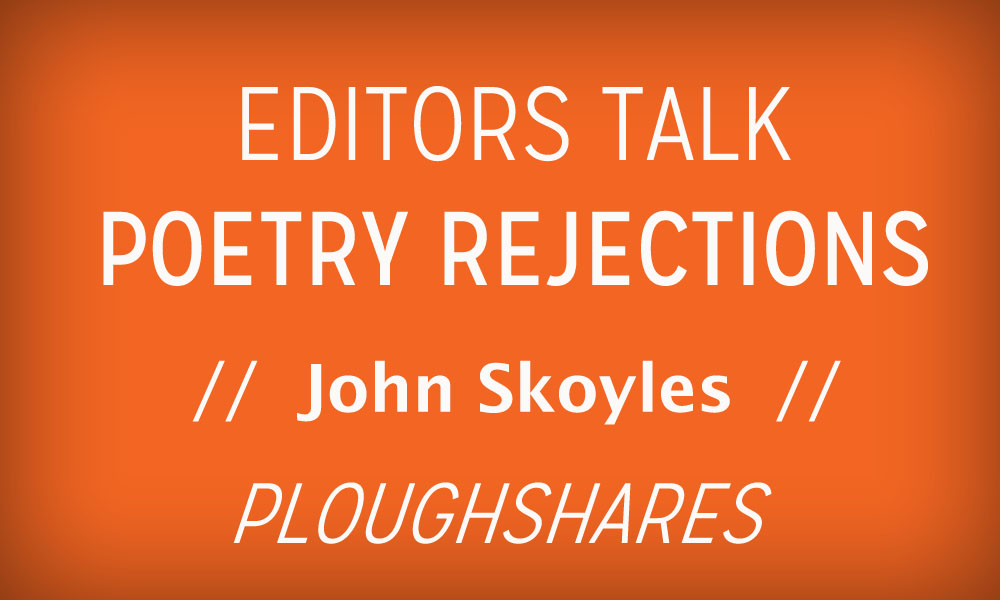Editors Talk Poetry Rejections: John Skoyles, Ploughshares

As a platform for emerging poets, our mission is to provide practical help for serious writers. The community lifts itself up together or not at all. In that light, we’ve been asking some great editors from around the literary community about reasons for why poems may get declined from their own slush pile of submissions, and what poets can do to better their chances. Today, we’re speaking with John Skoyles, the Poetry Editor of Ploughshares.
Frontier Poetry: From a craft standpoint, what causes you to reject a poem?
John Skoyles: The most obvious is the use of familiar language (clichés). Also, sometimes a poem is difficult to read, not due to heady content, but because the syntax is contorted, resulting in the additional problem of lack of music or even readability.
What advice do you have for new poets who are submitting work?
My advice is to send a poem out only when you are certain it is finished. And then not to take an editor’s rejection or acceptance as a verdict on the poem’s quality. It is not a judgement—it only shows an editor’s particular leaning. The other thing is not to take editorial comments on the poem too seriously—often, the editor likes a rejected poem enough to write a note, but just as often, the note, while well-intentioned, is written offhandedly, and as such it should not be taken as serious literary criticism.
To what degree is your publication able to offer feedback on rejected work?
As poetry editor, I don’t offer feedback on rejected work, but I do ask for more poems if the work interests me. Then again, I have often accepted a poem and offered a suggestion to the poet on a minor revision, with the understanding we will publish the poem as it stands, if the poet prefers the original version.
Do you remember repeat submitters?
Absolutely. We have an editor who reads the work of those who have been previously published in Ploughshares. Also, if I have written a note to a poet whose work has come close to publication, I will ask that poet to submit again, and to write in the cover letter something like, “Thank you for asking to see more poems.” This will get the poems directly to my queue.
Does your publication seek out specific styles or aesthetics of poetry that writers submitters should know about?
We have a wide variety of poet-screener-editors. If you look at an issue, you will find a range of aesthetics and well as poets at different stages of their careers, including many in print for the first time.
What book of poetry / craft would you always recommend to new poets? (And, optionally, why?)
A new poet would be well-served by reading anthologies such as The Ecco Anthology of International Poetry (Kaminsky and Harris); and The Vintage Book of Contemporary World Poetry (J. D. McClatchy). If the new poet feels a kinship with a particular poet, he/she should then seek out that poet’s books. Reginald Gibbon’s The Poet’s Work: 29 Masters of 20th Century Poetry on the Origins and Practice of their Art is a valuable collection of prose by great poets.
I like what Philip Larkin says: “Oh, for Christ’s sake, one doesn’t study poets! You read them, and think, That’s marvelous, how is it done? Could I do it? and that’s how you learn.”
When he was 90, Stanley Kunitz published a new book, and told me, “I wish I could tell you it gets any easier.” I did not find this at all daunting. I took it as a positive thing: that writing and learning about poetry was an infinite study. We are always learning, always discovering; it never ends, and that’s the joy of it.
John Skoyles is the author of four books of poems, all published by Carnegie-Mellon University Press: A Little Faith; Permanent Change, Definition of the Soul, and The Situation. He is also the author of two prose works: Generous Strangers, a book of personal essays (Kodansha, 1999), and Secret Frequencies: A New York Education, a memoir (Nebraska, 2003). His work has appeared in The Atlantic, Poetry, Yale Review, TriQuarterly and others. He has received two grants from the NEA as well as fellowships from the New York and North Carolina State Arts Councils.